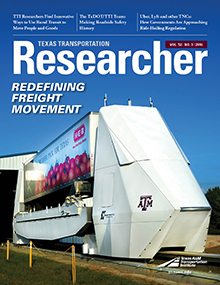
Agency Director
Without curious minds, our transportation system would, quite literally, come to a standstill. In a very real way, the transportation research process keeps the system moving, and that process starts with a seemingly simple question: How can we do this better? Asking that question shines the light of innovation on the status quo to help make transportation safer, smarter and more efficient.
Remember the 20th century? Way back in 1998, Texas A&M Transportation Institute (TTI) Senior Research Scientist Steve Roop came up with an idea for revolutionizing the way goods reach the marketplace. The goal involved creating a new way to move freight without adding congestion to our roadways and do it in an economically viable, safe way. In September 2016, nearly 20 years later, the world saw that vision fulfilled when Steve publicly demonstrated the Freight Shuttle System’s proof of concept for the first time.
I won’t go into the technical details of the Freight Shuttle here — you can read about those in the centerspread of this issue, which highlights the rollout attended by Texas Gov. Greg Abbott and Texas A&M University System Chancellor John Sharp, among other dignitaries. But I want to point out that TTI’s development of the Freight Shuttle concept guided by Steve’s expertise — and his dedication to seeing it done, despite many public and private barriers — exemplifies a researcher’s passion for what they do. Every day, transportation researchers combine intellectual curiosity with problem solving and outside-the-box thinking to find a better way.

This issue of the Texas Transportation Researcher looks at how Steve and other TTI researchers take innovative ideas and turn them into implementable results every day. For example, we’re helping to improve the quality of life for rural Texans by expanding last-mile package delivery options to include public transit systems. The rural planning workshops we’ve facilitated are helping local stakeholders better voice their transportation needs to the Texas Department of Transportation. And the Institute’s proud tradition of improving roadside safety devices continued this summer when TTI researchers successfully tested their solution to a 60-year-old, run-off-the-road problem.
Many new ideas, though, come with challenges for implementation. Transportation network companies (TNCs) like Uber and Lyft are under fire by some who see them as providing the same services as taxicabs without being held to the same standards. Experts with TTI’s Transportation Policy Research Center recently testified before the Texas Legislature about lessons learned in other states as Texas seeks to shape its own policies regarding TNCs. And this summer, TTI continued its university-based mission to educate the next generation of engineering professionals through the secondary school summer programs we support at the Institute.
I can’t tell you how proud I am of the researchers profiled in this and every issue of Researcher. As a transportation research professional myself, I know you don’t always have the right answer in mind when you begin a research project. But the discovery process itself, that moment when the light bulb goes on — that’s the fun part for the seeker of new knowledge. That’s the payoff for the intellectually curious. And it all starts by asking that first question. Sometimes, as with the Freight Shuttle, it just takes a while — and a dogged determination to keep searching — to find the better way.
